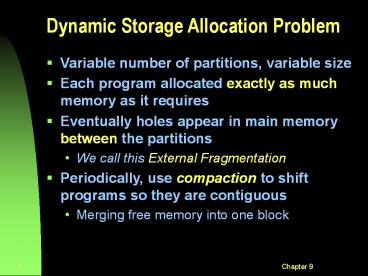Dynamic Storage Allocation Problem PowerPoint PPT Presentation
Title: Dynamic Storage Allocation Problem
1
Dynamic Storage Allocation Problem
- Variable number of partitions, variable size
- Each program allocated exactly as much memory as
it requires - Eventually holes appear in main memory between
the partitions - We call this External Fragmentation
- Periodically, use compaction to shift programs so
they are contiguous - Merging free memory into one block
2
Dynamic Storage-Allocation
- OS keeps a table indicating which parts of memory
are available and which are occupied. - Initially all memory is available for user
processes (set of holes contains 1 large hole) - When processes arrive and need memory, search for
a hole big enough - If a hole is too large, split in 2 (1 part for
process, 1 part returned to set of holes) - If new hole is adjacent to other holes, may be
merged to form 1 larger hole
3
Dynamic Partitioning an example
- (a-d) P1, P2, P3 are allocated memory.
- P4 needs 128k but after loading first 3, there
is only a single hole of 64k, so P4 must wait. - Eventually all 3 processes are blocked
- OS swaps out P2 (closest fit) and brings in P4
(128k)
4
Dynamic Partitioning an example
- (e,f) remove process 2, load process 4 leaves a
hole of 224-12896K (external fragmentation) - (g,h) Process 1 suspended to bring in process 2
again, creating another hole of 320-22496K... - Left with 3 small and probably useless holes.
Compaction would produce a single hole of
969664256K
5
Placement Algorithm
- Decide which free block to allocate to a program
- Possible algorithms
- Best-fit choose smallest hole that fits
- creates small holes!
- First-fit choose first hole from beginning that
fits - generally superior
- Next-fit variation first hole from last
placement that fits - Worst-fit use largest hole
- leaves largest leftover
(also worst fit)
6
Advantages/Disadvantages of Placement Algorithms
- First fit and best fit are generally better than
worst fit - Both are better in terms of storage
- First fit is faster than both best and worst fit
- All suffer from external fragmentation
- Exists enough total memory exists to satisfy a
request, but it is not contiguous (lots of small
holes) - Worst case can have small block of memory between
every 2 processes
7
Compaction
- External fragmentation can be resolved through
compaction - Shuffles the memory contents to put all free
memory together in one block - Compaction algorithm is expensive, but so is not
making efficient use of memory, especially with a
lot of concurrent processes - Only possible if relocation is dynamic
- Relocation requires moving program and data,
changing the base register
8
Relocation
- Because of swapping and compaction, a process may
occupy different main memory locations during its
lifetime - So we usually use special hardware to perform
address mapping to allow us to support relocation
at run time - We will distinguish between logical address and
physical address
9
Address Terminology
- Physical address a physical location in main
memory, from the point of view of the memory
system. - Logical (virtual) address an address as used in
a program, an address as generated by the CPU
when executing that program - so an address from point of view of the CPU
10
Memory Management Unit (MMU)
memory
relocation register (base reg) 14000 MMU
CPU
logical address
physical address
123
14123
- 32 bit address register 4 Gigabytes of virtual
memory - Actually only 64 (128..) Megabytes of physical
memory - Need to map down from a large virtual address
space to a smaller physical memory space
11
Paging
- Fragmentation is a significant problem with all
these memory management schemes - Lets organize physical address spaced (main
memory) into equal (small) sized chunks called
frames. - And divide logical (virtual) address space into
chunks of the same size called pages - The pages of a program can thus be mapped to the
available frames in main memory, not necessarily
contiguous - Result a process can be scattered all over the
physical memory.
12
Example of Program Loading by Page
- ..now suppose that process B is swapped out
13
Process Loading by Page
- Now process D consisting of 5 pages is loaded
- Program D does not occupy a contiguous section of
memory - No external fragmentation!
- Internal fragmentation limited to part of the
last page of each program (average 1/2
page/program).
14
Page Tables
- We keep a page table for each process
- A page table entry is the frame number where
the - corresponding page is physically located
- Page table is indexed by page number to obtain
the - frame number
- We also need a Free frame list to keep track of
- unused frames
15
Logical Address in Paging
- Within each program, each logical address
consists of a page number and an offset within
the page - A Memory Management Unit (MMU) is put between the
CPU address bus and physical memory bus - A MMU register holds the starting physical
address of the page table of the process
currently running - Presented with a logical address (page number,
offset) the MMU accesses the page table to obtain
the physical address (frame number, offset)

